At the beginning of Spring Term back at the University of Reading, I presented a VIVA Presentation (PDF), showcasing the artwork and subsequent ideas that were produced on my term abroad at the University of Ottawa.
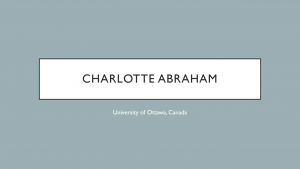
I was to present the artwork created during my two practical modules of sculpture and photography, and the assignments of each.
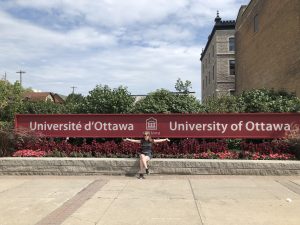
The first photography assignment looked at the process of using the darkroom and objects at different heights from light sources and the photographic paper. There was a play of materials with greater thinking outside of the box to manipulate found objects. Inspiration for this project was Oscar G. Rejlander who is also known as the grandfather of photography. His works manipulate negatives several times to produce new photographs.
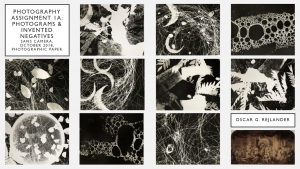
In the first photography assignment, there was also the use of pinhole cameras. Pinhole cameras have the same principles of a normal camera, but you have much more control over each element. You have to manually control the shutter speed and insert the photographic paper (instead of film or an SD card). My own camera had an exposure time of five minutes. Images would come out negative, so we had to use a dark room process for them to become positive photographs. This part of the assignment let me explore the unknown, especially with composition and objects, as well as getting used to the darkroom and the processes within there. If there was a chance to do the project again, I would have wanted to do a wider variety of simple photograms and invented negatives with different materials, as these had worked best. I would also try to get a cleaner developing technique as a streak of black can be seen throughout many of the images.

The second photography assignment we worked with 35mm black and white photography. The brief was to take photos of things you haven’t seen before, or take photos of things in new ways. Not only was thinking of new perspectives challenging, but the process of developing our own film raised concerns within this project too. I felt like I had a small advantage as everything was new to me, but it also stretched my knowledge of SLR cameras and the way in which we can angle ourselves, let alone the camera, to change perspectives. There was also development in the darkroom whereupon I used different filters to reduce the number of greys within the image, which can be seen in the bottom photograph. The techniques of dodging and burning were unsuccessful, however the final images were crisp and clear with a high range of tones.

For this project, I took inspiration from Andrew Wright, whose series of trees are put back in a vertical position.
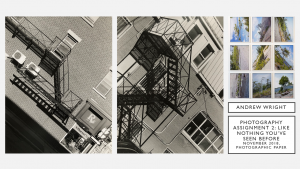
The third, and final, photography assignment emulated and took inspiration from Harold Edgerton, who created strobe lighting and photographed the extraordinary in the everyday. I chose to emulate the milk drop coronet by using a self-designed three-dimensional print of a milk drop. I took inspiration from his everyday photographs to create the cards and the tap. Throughout each image, there is a confusion of reality because of the manipulation of each of the objects. The final display of the images was more professional than previously, adding a sense of completion to the images and project.

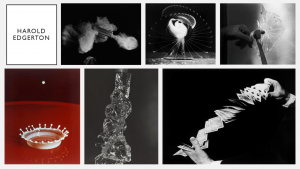
The stereotype series was a response to a call for international students at the university of Ottawa to create artwork that comment on breaking stereotypes. I created a 20 image series that show people aren’t always the label that you give them. This has now been published on the university’s news website. The prints and negatives themselves were not perfect, however the central idea, that people do not live under the stereotypical labels that we may give them, was still projected.
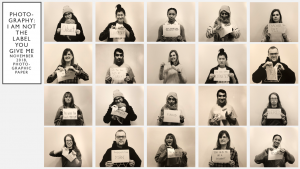
The sculpture module was more of an exploration of materials and how far we can stretch them, and learn from them. Within the plaster project, I used the processes of; two-part mould, alginate, relief mould, and generally handling the plaster in thin and thick consistencies. The head, which was the main part of the project, used found objects and is a result of learning more about the materials and how I was to manipulate it with cardboard, cheese-cloth, wire and cotton wool.
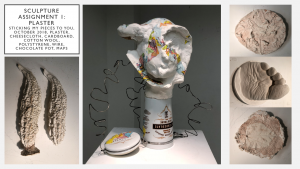
The second sculpture assignment was another exploration of material and process, but this time with wood and metal. I was able to transform two children’s chairs into part of a tortoise shell, using as much of the wood as I could to preserve each part of the chair in a new way. MIG welding was used on metal rods to create the empty section of the shell. It was said by others that in the final piece, there is a clear sense of enjoyment of the exploration of material and process. I was inspired by Ben Woodeson for this project, who balanced glass without fixings. The wood and metal are not fixed together in this piece, creating the sense of fragility.
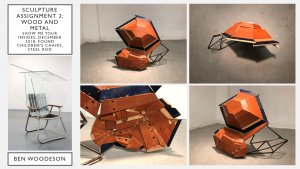


Leave a Reply